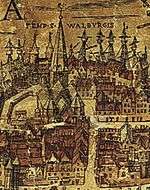St Walburga Church (Antwerp)
The St Walburga Church (or Burchtkerk) in Antwerp, Belgium, formerly a parish church, was demolished in 1817.

Early history

The church's history predates the 8th century. The very first chapel built within the walls on the right bank of the Scheldt dates from 727, and was destroyed by the Normans in 836. In 900 a new burcht is built on the same spot with a new church, dedicated to Saint Walpurga, next to the fortress Het Steen. Under the direction of the Affligem monks the church is rebuilt in 1250, and in 1478 it becomes a parish church, also receiving a baptismal font and the right to bury. Another renovation, directed by architect de Waghemakere around 1500, again enlarges the church.
Interior
In 1609 the church council asked Peter Paul Rubens to paint a triptych for the church; his Elevation of the Cross is finished in 1610 and is incorporated into the main altar. When the old wooden altar is demolished and replaced by a stone altar (the work of Willem Kerrickx) in 1734, smaller parts of Rubens's triptych are sold because they don't fit in the new altar. The first mass at the high altar took place on 11 June 1737. The triptych was removed in 1794 by French occupying forces and taken to Paris, and was later returned to Antwerp's Cathedral of Our Lady.
Closing, demolition

In 1798 the church fell victim to the French urge to close monasteries and churches, and that same year the Antwerp diocese was abolished. The church was used as a warehouse. The choir, including a covered walkway to Het Steen, was retained for a while but in 1816 the church was sold, and demolished the year after. The last remains of it were destroyed by fire. In the meantime the St. Paul's Church had been designated parish church. The removal of the St. Walburga Church left an open space, now called the Burchtplein, on which a statue to Peter Paul Rubens was placed. When the banks of the Scheldt river were straightened, the square disappeared and the statue was moved to the Groenplaats.
The church's predella was reused for the main altar of the Antwerp Cathedral; another altar was moved to the Saint Dionysius church in Tilburg, where it became the high altar. In 1936, a new, modernist church with the same name was built by Flor Van Reeth in the Zuid neighborhood of Antwerp.
Burials
- Joannes I Goubau, Lord of Saint-Fontaine, (1503-1581): marr. Joanne Cossiers.
- Abrahem van Horne, marr. Barbe van den Gouwen.
- Michiel Cornelissen Stellenaer, capteyn.
- Jan Pieter van Baurscheit the Elder.